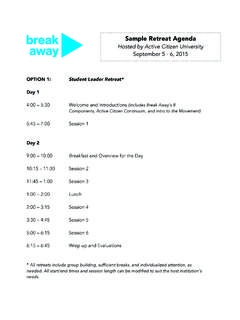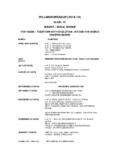Transcription of Training Your Racing Pigeons to Break
1 28/8/2014 Training your Racing Pigeons to Break | pigeon Racing and Racing Pigeons Secrets | The pigeon your Racing Pigeons to BreakTraining your Racing Pigeons to BreakWhat is breaking? Breaking is when a birdseparates from a flock andheads out on his own course. If you observe a flock of racingpigeons you will notice there is usually on leader once theyare on a straight course. Occasionally there are a few thatswitch back and forth. The question is what are the otherbirds in the flock doing? They are following the leaders. When we talk about breaking then, we are also talking to undo instinctsPigeon by nature are gregarious. They want to be together for security. Young birds especially have a hard timebreaking. It s in their instincts for survival. The predators usually seek out the loner as it might be sick or injured whichin nature would be the reason the bird would be solo.
2 Yet our goal is to have winners and leaders. When we train toproduce leaders and birds that Break we are attempting to train against instincts. This is important to do you develop leaders and birds that Break ?Breaking and leading are two different things. A leader is in front of the flock following his own course but with thesecurity of the flock. The bird that breaks is on his own, but also following his own course. The common denominatoris that both are following their own course. This is what we must train our Racing Pigeons to do. We must train them tofollow their own are two methods in teaching the birds to follow their own course. The first is by single tossing. The bird has nochoice but to follow his own instincts and choose the way home. Single tossing is time consuming depending on thesize of your flock but is a very valuable Training technique.
3 For pigeon fanciers two of the most precious commodities aretime and second method is to toss birds in small groups. I feel that tossing in small groups is better than single tossing. Ittakes less time and when birds are in small groups, they are still Racing each other and battling to be leader. Start outby breaking your flock into 3 groups. For that toss there should have been at least three leaders, often more, as thebirds battle for the lead position. Later, you can Break them down into smaller groups of less than ten and eventuallydown to groups of three. In small group tossing you are developing leaders, which is developing the same instinct thatwill produce birds that will Break and follow their own tossing small groups or individual Pigeons it is important to make sure they do not get together into one largegroup.
4 Often a flock may appear to go out of site and eventually fly back over the release point 10-15 minutes later. Once way to try to prevent this is to let the birds go at not only different time intervals but also at different distances. Choose the distance that you want to train from. Find a very close road that runs perpendicular to the distance. Let onegroup go. After they are out of sight, drive 1-5 miles and let another group go. Repeat until all the groups have beenreleased. This may prevent them from grouping up into one larger experiences from small group Record Keeping Templates28/8/2014 Training your Racing Pigeons to Break | pigeon Racing and Racing Pigeons Secrets | The pigeon Here to Check it Out NowWhat is the ONE thing that ALL champion fanciers have in common?
5 They All Keep Good Records!Record keeping allows you to consistently better your birds and raceteams proper record keeping it allows a fancier the ability to look back at allof your bird s past Training , Racing and breeding performances and seewhich bird s performed the best and which didn are 8 Proven Record keeping templates that are essential for any fancier and easy to use and are the sameexact record keeping templates the champions use to document their bird s performance. This is everything youneed to keep world class records of all your bird s!Often when we have a Training toss we gauge the success or failure of the toss on how the Pigeons arrive home. Weare not able to see what the birds do between the release point and the arrival home. The only factor we can see andmeasure is when they arrive home and in what condition they arrive.
6 When we release the birds as one large group, wehave only one measure of how the birds I started tossing in smaller groups, I made some interesting observations. I would often toss my birds in 3groups of approximately 12-20 Pigeons each. I would record what time I released each group, how long it took for themto leave out of sight and what heading they were last seen at. When my Racing Pigeons arrived home, they had Taurisbands on and were also clocked by the computer if they arrived home before times, two groups would come home together yet another group would come home in singles and doubles. Other times the last group released would be the first group home and the first group released would be the last toarrive. One group would make excellent time and another would take twice as long to get do you end up with such different results when all groups were released from the same point?
7 As stated before,we are only observers of the release and the arrival but not the dynamics of what happen between those points. Myconclusions then are only theories as they can not be proven until one can observe the dynamics of the actual trainingflight. Here are my ideas on why we have such strange can often observe at the release point that the birds will start to head out one direction with one leader and then adifferent bird gets in the front and they take a new heading. Or sometimes, one bird starts to Break and the flock turns to pick them up staying true to their gregarious nature. There is a battle for the lead position and the direction of travel forthe entire group then depends on who is holding that lead position. I think this explains the return of singles anddoubles.
8 I believe that if the lead bird takes the flock on the wrong heading, slowly, the other birds realize this, Break offand head home on their own. This would explain why there would be such a broken the case of one group doing poorly and the other groups having a good toss could be explained by the same event. The leader of the poorly performing group took them on longer flight but not enough for the entire group to Break oreventually a different bird took lead and brought the team home on the right any flock there are excellent birds and poor birds. There will always be a battle for the lead position. Until the poorleaders are lost from Training , there is always the chance of a poor return. So this is the secondary goal of our Training . To train until we have enough confident leaders and any birds that are true followers or dummies are gone from your Racing Pigeons to Break by Domanski Family Lofts




